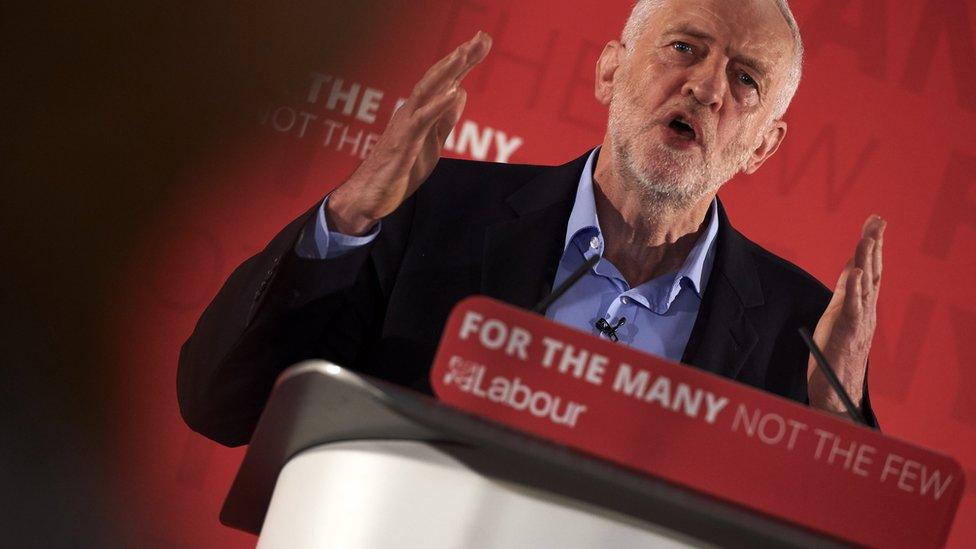Unpacking the election row over spending
- Published
- comments

Today the future of the economy moved centre stage in the election battle.
And the fireworks started.
Overnight, the Conservatives claimed that Labour had a £45bn "black hole" in its spending plans.
Its "dossier" says the party has added up the spending commitments made by Labour since 2015, from scrapping the benefits cap to supporting the introduction of 10,000 new police officers.
The Tories say the total cost of these policy commitments is £64.8bn by 2020.
Now, some of those spending pledges are offset by increased taxes, the Conservatives say.
Labour has said it will raise corporation taxes and reverse planned cuts to capital gains tax.
The Tories claim that will raise £14.1bn over the same time period - leaving the "black hole" figure, the gap between their analysis of increased spending and increased revenues under a future Labour government.
Labour has dismissed the document as "misinformation and misrepresentation", saying the Tories have costed policies that Labour is not committed to and failed to give their own commitments on tax and spending.
So how do voters make sense of the row - the first, I am sure, of many on the economy during this election campaign.

After all, despite the focus on Brexit, voters still put the economy and worries about issues such as rising prices towards the top of their political concerns.
It's the economy...
It is still the economy, stupid, when it comes to winning general election campaigns.
First, it is correct to say that Labour has committed to some spending increases such as restoring the education maintenance allowance, restoring student grants and adding to the number of police officers.
It says all of these are fully funded by increasing corporation tax and reversing the cuts to capital gains tax.
So, voters can judge, voting Labour will lead to an increase in some taxes to pay for new policies.
Other possible spending commitments contained in the Tory dossier - such as on arts funding - are more difficult to nail down and are just that - possible.
Let's take one - that Jeremy Corbyn wants to increase the proportion of gross domestic product the government spends on the arts to match the European average.
The Tory document also says that "Labour will reverse Tory real terms cuts to arts expenditure".
Mr Corbyn did say that he would reverse arts spending cuts made since 2010, at an event in Edinburgh in August 2016.
But Labour's general election campaign chief, Andrew Gwynne, has pointed out that this is not official party policy.
For that, voters will need to wait for Labour's manifesto, which is expected to be published in the week starting 15 May.
Some talk by Opposition politicians about what they might like to do is just that - talk. It can be criticised - maybe - for being "loose-lipped", but it does not make it an official spending commitment.

Dividing line
What today has revealed is that there is a fundamental dividing line between the two parties.
Labour will raise some taxes and fund some new policies.
The Conservative offer is different.
They will seek to balance the amount the government spends with the amount it earns in taxes, reducing the deficit to zero.
They say by this method - and by keeping businesses taxes lower - the economy will strengthen, government revenues will increase and support for public services will improve.
Don't deliberately borrow more now is the message.
Another elephant
There is another big elephant in the room.
Most of the Tories' "black hole" claim is made up of the £35bn it says the Labour Party is committed to spending on improving Britain's infrastructure, such as providing better high-speed broadband.
Labour has certainly spoken about investing £500bn over 10 years "in infrastructure, manufacturing and new industries".
According to an interview given by the shadow chancellor, John McDonnell, in September 2016, £350bn of that will come from central government - so the Tory "£35bn a year" figure of new spending on infrastructure (£350bn phased over 10 years) does not appear to be disputed.
Although, again, we will have to wait for Labour's manifesto to see if that £350bn pledge is repeated.
It's the impact of the pledge that is in dispute.
The Conservatives say that the infrastructure money will have to be borrowed, adding to the £1.7trn debt pile the country is already carrying.
Mr McDonnell says that capital spending for investment should not be viewed as adding to a "black hole" as it is not day-to-day spending.
Under the present public accounting system, nearly all spending commitments - whether current (day-to-day) or capital (investment) - is added to the public sector net debt figure.
So, increasing borrowing means the national debt rises and funding the costs of the debt also increases.
Mr McDonnell argues that borrowing rates on the international markets are cheap (true historically, although the rates are ticking up) and that the economic return on new projects outweighs the cost.
Economic growth
If the economy grows, government income increases and deficit levels fall, Labour argues.
There is one simple point at the heart of this row.
The Conservatives say they are the party of economic stability, and that by maintaining strong controls on the public finances, national wealth will grow.
Labour says that borrowing to invest will also lead to economic growth.
Numbers will be thrown around.
The moment to take notice is when the manifestos are published - by all the parties.
What commitments are made on policies, on spending and on taxes?
And what effect might that have on the economy.
Which is what, after all, many people will vote on.